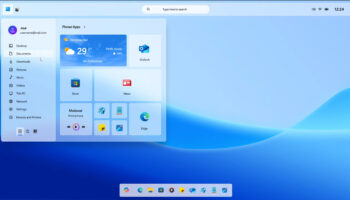Meta introduces more affordable Quest 3S headset

Meta has introduced the Quest 3S, a more budget-friendly addition to its mixed reality headset lineup. Announced at the Connect event, the Quest 3S offers the same performance and mixed reality capabilities as the Quest 3, but at a lower price. Starting at $299.99, the device targets newcomers to mixed reality or users seeking an affordable upgrade from earlier models like Quest or Quest 2.
The Quest 3S includes features such as watching TV on a virtual large screen, personal fitness training, and multitasking capabilities. The headset builds on the Quest 3’s foundation, which introduced full-color Passthrough for blending the virtual and physical worlds. Meta continues to make improvements to its mixed reality ecosystem, with the Quest 3S benefiting from updates like enhanced spatial audio and improved contrast and color for a more realistic Passthrough experience.
As the workforce trends younger, account takeover attacks are rising

Account Takeover (ATO) incidents are on the rise, with one recent study finding that 29 percent of US adults were victims of ATO attacks in the past year alone. That isn’t necessarily surprising: what we call an “Account Takeover attack” usually comes as the result of stolen credentials -- and this year’s Verizon Data Breach Investigations Report (DBIR) noted that credential theft has played a role in a whopping 31 percent of all breaches over the past 10 years. Basically, an ATO happens when a cybercriminal uses those stolen credentials to access an account that doesn’t belong to them and leverages it for any number of nefarious purposes.
Those credentials can come from anywhere. Yes, modern attackers can use deepfakes and other advanced tactics to get their hands on credentials -- but the truth is, tried-and-true methods like phishing and business email compromise (BEC) attacks are still remarkably effective. Worse still, because people tend to reuse passwords, a single set of stolen credentials can often lead to multiple compromised accounts. As always, human beings are the weakest point in any system.
RTOS vs Linux: The IoT battle extends from software to hardware

There’s certainly something happening regarding operating systems in the Internet of Things (IoT). Chips are getting smarter, devices are getting smaller, and speeds are getting faster. As a result, device developers are more often experimenting with their operating system of choice, moving away from Linux and toward real-time operating systems (RTOS).
This is an evolution on two fronts. On the software side, applications requiring low latency and deterministic responses are turning to Zephyr, FreeRTOS, and ThreadX. And now, on the hardware side, we’re seeing more chip manufacturers entering the fray with RTOS-specific hardware that rivals or surpasses performance of entry-level Linux boards. This is a big deal since these chips optimize hardware-software integration, creating a more thorough ecosystem for purpose-built solutions with RTOS.
Samsung unveils 990 EVO Plus SSD with PCIe 4.0 and 7,250MB/s read speeds

Samsung has announced its latest solid state drive -- the 990 EVO Plus. This SSD features PCIe 4.0 support and advanced NAND technology. Built for gamers, content creators, and business users alike, the 990 EVO Plus provides a balance of speed and efficiency.
The new SSD offers sequential read speeds of up to 7,250MB/s and write speeds of 6,300MB/s, marking a substantial 50 percent increase in performance over the previous 990 EVO model. This performance boost is powered by Samsung’s 8th-generation V-NAND technology and a 5-nanometer controller. The innovative nickel-coated heat shield helps keep the SSD cool, improving power efficiency by 73 percent compared to its predecessor.
Save $31.99! Get 'Mastering Spring Boot 3.0' for FREE

Mastering Spring Boot 3.0 is your gateway to building scalable and robust backend systems using the latest techniques. Penned by a seasoned software developer with 20+ years of experience in the tech industry, this book follows a hands-on, step-by-step approach to helping you understand Spring Boot concepts and apply them to real-world projects.
You’ll start by exploring key architectural patterns such as DDD, CQRS, and event sourcing. Next, you’ll focus on the nuances of reactive REST development, delve into advanced testing strategies, and fortify your applications' security. You’ll also discover the power of containerization and orchestration with Spring Boot 3.0 and unlock its potential for smooth deployments.
Reolink launches Altas PT Ultra 4K battery camera with continuous recording and optional solar panel

Reolink has officially launched the Altas PT Ultra, a new 4K battery-powered camera offering continuous recording. This security camera combines 4K UHD resolution with auto-tracking and color vision for day and night monitoring.
The camera is designed to address common issues in home security cameras, such as missing events and limited battery life. It comes equipped with a 20,000mAh battery, offering up to 12 hours of 4K recording per day for eight days on a single charge. In standby mode, it can last up to 500 days.
Unforgiving consumers says poor software is as bad as contaminated food

A new survey from software delivery platform Harness finds that 66 percent of UK consumers think software companies releasing 'bad' code that causes mass outages is on par with, or worse than, supermarkets selling contaminated products that break laws on food safety.
The study of 2,000 UK consumers, conducted by Opinium Research, finds that 44 percent have been affected by an IT outage. 26 percent were impacted by the recent incident caused by a software update from CrowdStrike in July 2024.
Enterprises suffer surge in mobile phishing attacks

Cybercriminals are increasingly adopting a 'mobile-first' attack strategy to infiltrate enterprise systems by targeting weak, unsecured, and unmanaged mobile endpoints, recognizing mobile as a major entry point to corporate networks and sensitive data.
A new report from Zimperium zLabs shows a significant rise in mobile phishing -- or 'mishing' -- a technique that employs various tactics specifically designed to exploit vulnerabilities in mobile devices.
Can humans provide a cybersecurity edge? [Q&A]

It's usually the case that cybersecurity is seen as being all about technology and that humans -- making mistakes and falling for social engineering -- are something of a liability.
But are people really just a problem or can they also be part of the solution? Toney Jennings, CEO of DataStone, believes we need to shift our thinking away from the current paradigm to empowering people as a hidden asset in the protection of their organization. We talked to him to find out more.
Attackers use GenAI to write malicious code

The latest threat insights report from HP Wolf Security has identified a new campaign using malware believed to have been written with the help of GenAI.
Analysis of the campaign, targeting French-speakers using VBScript and JavaScript, finds the structure of the scripts, comments explaining each line of code, and the choice of native language function names and variables are strong indications that the threat actor used GenAI to create the malware.
New York Times expands podcast subscriptions to Apple Podcasts and Spotify

The New York Times is introducing paid podcast subscriptions on Apple Podcasts and Spotify, giving listeners the ability to subscribe directly through these platforms. This expansion builds on the success of The Times’ audio journalism efforts, which began with the launch of “The Daily” in 2017. The Times’ podcasts now reach millions of listeners, offering in-depth reporting and analysis on a range of topics.
In addition to The Times’ stand-alone Audio app and the Listen tab in The New York Times app, this partnership with Apple Podcasts and Spotify is aimed at making its subscription service more accessible. Users with an existing subscription through The Times app will have their accounts automatically connected when using Apple Podcasts. Those without a subscription can sign up through the New York Times channel on both platforms.
Marshall and Green Day’s Billie Joe Armstrong deliver ‘Time of Your Life’ with new Monitor III A.N.C. wireless headphones

Marshall has teamed up with Green Day’s Billie Joe Armstrong to launch the Monitor III A.N.C. wireless headphones. The headphones feature 70 hours of playtime with active noise cancellation (ANC) enabled, or 100 hours without ANC. Marshall’s new Soundstage spatial audio technology promises an immersive experience, while Adaptive Loudness adjusts sound levels based on environmental noise without compromising quality.
Weighing just 250 grams, the headphones offer long-lasting comfort thanks to redesigned cushions and a lighter frame. They also feature a 2.5-hour charge time via USB-C, ensuring you get back to listening quickly. The rugged and foldable design offers optimal portability, and the customizable M-button allows for personalized control over EQ settings, voice assistants, and Spotify.
NETGEAR expands Nighthawk Wi-Fi 7 lineup with RS600, RS500, and RS200 routers

NETGEAR has expanded its Nighthawk Wi-Fi 7 router lineup with three new models -- the RS600, RS500, and RS200 - offering a range of options for different home sizes and budgets. These routers bring the power of Wi-Fi 7, which is 2.4 times faster than Wi-Fi 6, to more households, delivering ultra-fast speeds, low latency, and advanced network security.
The RS600 is the top-tier model, covering up to 3,300 square feet with speeds up to 18Gbps. It supports up to 150 concurrent devices, making it ideal for homes with multi-gig internet speeds over 1Gbps. This router features tri-band WiFi 7 technology, offering 10 simultaneous Wi-Fi streams, and comes equipped with two 10GbE ports and three 1GbE ports for wired connectivity. It also includes state-of-the-art security with WPA3 encryption, VPN support, and automatic firmware updates. For added protection, the RS600 comes with a 30-day trial of NETGEAR Armor, powered by Bitdefender, providing real-time threat detection and protection for all connected devices.
Phishing and deepfakes are leading AI-powered threats

A new survey of cybersecurity professionals finds that 75 percent of respondents think phishing attacks pose the greatest AI-powered threat to their organization, while 56 percent say deepfake enhanced fraud (voice or video) poses the greatest threat.
The study from Team 8, carried out at its annual CISO Summit, also finds that lack of expertise (58 percent) and balancing security with usability (56 percent) are the two main challenges organizations face when defending AI systems.
AI for social good: Highlighting positive applications of AI in addressing social challenges -- along with the potential pitfalls to avoid

Depending on who you ask, artificial intelligence could be the future of work or the harbinger of doom. The reality of AI technology falls somewhere between these two extremes. Although there are certainly some use cases of AI technology that could be harmful to society, others have seen the technology substantially improve their productivity and efficiency.
However, artificial intelligence has even more significant implications than improving the productivity of workers and businesses. Some use cases of AI have been proposed that could have profound social implications and address social challenges that are becoming more pressing today.
Most Commented Stories
© 1998-2024 BetaNews, Inc. All Rights Reserved. Privacy Policy - Cookie Policy.




